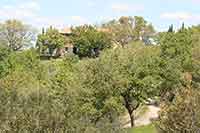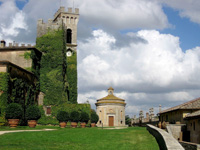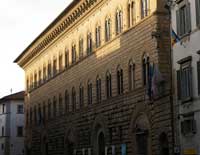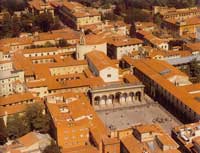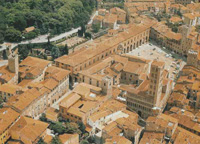| |
|
| |
|
|
|
|
|
|
| |
 |
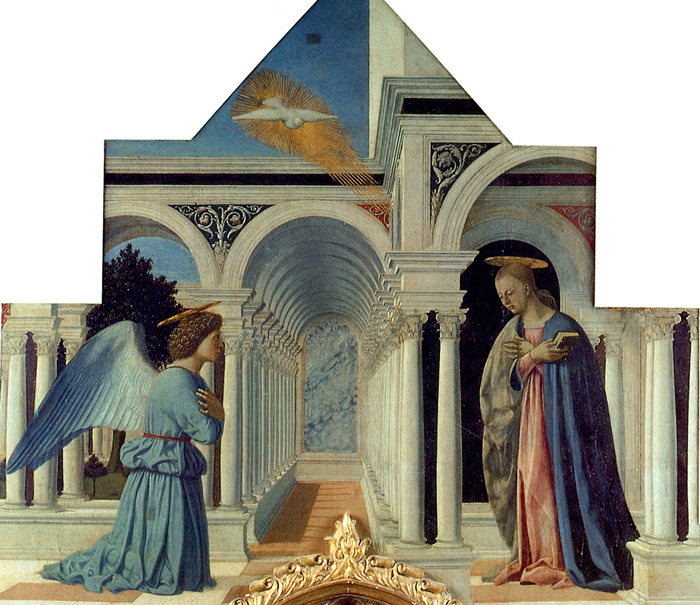 |
|
Piero della Francesca, Polyptych of St. Anthony, detail, Oil and tempera on panel, 338 cm × 230 cm,
Galleria Nazionale dell'Umbria, Perugia |
|
 |
|
| |
|
|
|
| |
|
Polyptych of Perugia, also known as Polyptych of Saint Anthony (1460-1470)
|
|
|
|
| |
|
The Polyptych of Perugia (also known as Polyptych of St. Anthony) is a complex of paintings by the Italian Renaissance master Piero della Francesca, finished around 1470. This complex painting, now housed in the Pinacoteca Nazionale (Galleria Nazionale dell'Umbria) in Perugia, was started immediately after Piero's return from Rome, but is was finished only several years later.
The work was executed for the Franciscan convent of Sant'Antonio da Padova in Perugia, most likely in the years following his sojourn in Rome. It portrays the Virgin enthroned with the Child in the central part, flanked by several saints: Anthony of Padua and John the Baptist on the left, Francis and Elizabeth of Hungary in the right. In the cusp is the Annunciation. The upper part of the predella shows the saint Claire and Lucy, while in the lower part are stories of the main saints.
The central part of the polyptych shows a still archaic style, both in the composition of the frame and in the gold background: Piero della Francesca was in fact called to complete a work already begun by a local painter. Also of lesser quality are the predella panel, which are in fact attributed to assistants. More innovative and typical of the artist's style is the Annunciation, set in a bright cloister, whose illusionist view is considered amongst the greatest perspective renderings of Renaissance art.[1]
|
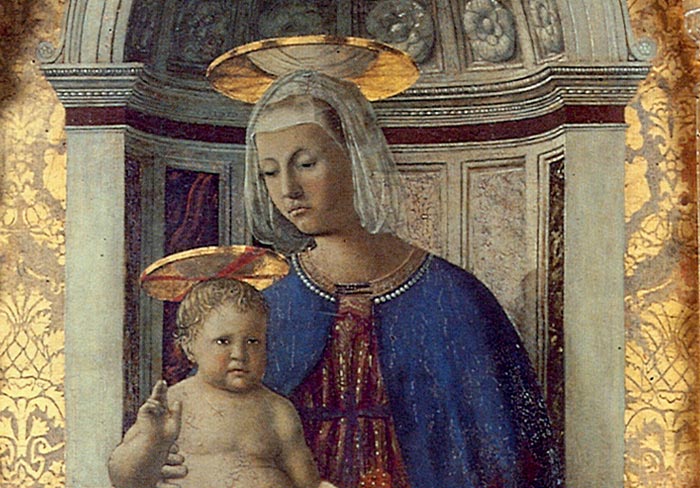 |
Piero della Francesca, Polyptych of St. Anthony, Oil and tempera on panel, 338 cm × 230 cm, Galleria Nazionale dell'Umbria, Perugiagia
|
The central part of the composition, the Madonna and Child with Staints Anthony, John the Baptist, Francis and Elisabeth, reveals in its unusual damask-like background the artist's aquaintance with a trend of contemporary Spanish painting, which Piero would have had the opportunity to see in Rome. We can therefore date the panel at around 1460. The polyptych is also made up of three predella panels showing St Anthony of Padua resurrecting a child, the Stigmatization of St Francis and St Elisabeth saving a boy who had fallen down a well, as well as two roundels placed between the main panel and the predella. The quality of this predella is extraordinary: Piero's characteristic spatial and light values are achieved here, on a small scale, by emphasizing the white walls of the interiors, the splashes of light and the deep shadows of the night scene in the open countryside. These scenes, where the bodies and even the shadows are fully three-dimensional, were to set an example for predella panels which was widely followed by Italian artists of the second half of the 15th-century, from the young Perugino to Bartolomeo della Gatta and, via Antonello da Messina, to the Neapolitan 'Master of Saints Severino and Sossio'. A few years later, Piero della Francesca completed the Perugia polyptych: above the ornate and still basically Gothic frame, he painted his extraordinary Annunciation.
The lack of compositional unity with the central part of the polyptych has led some scholars to suggest that Piero simply added this Annunciation to the altarpiece, much later.
According to others, the whole polyptych has a structural unity; Piero simply cut out the top part, originally intended to be rectangular, and transformed it into a sort of cusped crowning. Once again Piero has succeeded in overcoming the limitations imposed by patrons with old-fashioned artistic taste, giving us one of the most perfect examples of his use of perspective. Thanks also to his use of oil paints, Piero della Francesca achieves the extraordinarily detailed depiction of the series of capitals, running towards the vanishing point. Each architrave, and each column as well, projects a thin strip of shadow into the splendid cloister arcade, which appears to go beyond any inspiration derived from Alberti's architecture. The subtle analysis of the decorations painted on the walls reaches an unprecedented level; yet everything is contained in a single and organic space. Distances, so perfectly calculated, are neither forced nor artificial: they are conveyed by the realistic light and atmosphere.
|
|
|
|
|
|
| |
|
The panels represent St Augustine (132 x 57 cm, Museo de Arte Antiga, Lisbon), and St Michael the Archangel (133 x 60 cm, National Gallery, London).
St Augustine, portrayed with a mitre and a splendid bishop's cope is one of the high points of Piero's painting, for here he achieves perfect harmony between the imposing solidity of his three-dimensional forms and his miniaturistic attention to detail. Since the art of Gentile da Fabriano, no Italian painter had succeded in giving such a detailed reproduction of a saint's vestments. Piero paints every single scene depicted on this precious cope as though he were painting a small predella panel, using, for the soft decorations of the fabric, a "dot" technique worthy of a miniature by Fouquet. And yet, it is the monumental values that prevail in the figure of this austere saint.
St Michael the Archangel is portrayed as an ancient warrior, his athletic limbs made more elegant by his precious armour, by the graceful tunic and by his beautiful boots decorated by with tiny pearls. There is nothing violent nor dramatic in the killing of the dragon, who is shown as a snake, its decapitated body lying on the ground. |
|
|
| The panels represent St John the Evangelist (132 x 58 cm, Frick Collection, New York), and St Nicholas of Tolentino (133 x 60 cm, Museo Poldi Pezzoli, Milan).
In 1454 Piero agreed to paint polyptych for the Augustinians of Borgo San Sepolcro; the painting was to be finished within eight years and was intended for their monastery. As usual, the work was not completed until much later. The polyptych later was replaced and dimembered. It was only in this century that scholars succeeded in reconstructing this work. Among the parts of the polyptych that have unfortunately not survived there is also the central panel. The panels that originally formed the predella are in the Frick Collection in New York. The figures of four saints are the outer decorations.
Against a background which is a realistically constructed space with a marble ballustrade stands the figure of St John. It is dynsmic yet elegant. His lined face, surrounded by white hair, his bony hand weighted down by the heavy book, even the ornate borders of the garment that unexpectedly shows through under the wide cloak, are elements that stand out and appear to force their way through Piero's earlier sense of measure.
St Nicholas of Tolentino is a more original figure: the austere and calm features of his round face almost create a the effect of a portrait. This panel was part of a now dismembered polyptych which was executed by Piero between 1454 and 1469. Other panels of similar format are in the National Gallery, London, Frick Collection, New York, and Museu Nacional de Arte Antiga, Lisbon. |
|
|
| |
|
|
| |
|
|
[1] Vasari says that this is one of the several works that Piero painted during his stay in Perugia. He describes this polyptych, which was ordered by the sisters of the convent of Sant'Antonio da Padova, with great admiration.
The central part of the composition, with the Virgin with the Child and the Saints (St. Anthony, St. John Baptist, St. Francis and St. Elisabeth) on a damask-cloth background, shows the artist's knowledge of the approach of the Spanish painters of the time, whom he could have met in Rome. This panel can therefore be dated to the years around 1460. On the predella there are three panels that show Saint Anthony from Padua resuscitating a child, the Stigmata of Saint Francis and Saint Elisabeth saving a child fallen in a well. There are also two medallions between the main panel and the predella. The latter is an extraordinary work of art: it shows Piero's typical handling of space and light values, on a smaller scale, with an emphasis on the white walls, on the splashes of lights and shadows in the night scene outside. These scenes, where bodies and shadows are fully three-dimensional. , became a model for predellas followed by the most famous Italian artists of the late XV century, such as the young Perugino and Bartolomeo della Gatta and, through Antonello da Messina, down to Naples, with the Maestro di San Severino e Sossio. Piero finished the polyptych a few years later: above the decorated gothic frame he painted his superb Annunciation. The lack of unity with the polyptych central part has induced some scholars to hypothesise that Piero might have added this Annunciation much later. Still, the polyptych has its own structural continuity; Piero simply cut the upper part, which originally had to be rectangular, turning it into a pinnacle-shaped frame. Here too Piero went beyond his client's restrictions based on traditional artistic taste and gave us one of the most perfect examples of the use of perspective. Through his mastery in the use of oil colours, Piero della Francesca produced amazing details on the series of capitals that run towards the vanishing point. Every architrave and every column project a thin shadow in the attractive arched cloister that goes beyond the inspiration he took from Alberti's architecture. The subtle analysis of the wall decorations reaches a unique level, with every single element included in an organic space. Distances are calculated perfectly, they are neither forced nor artificial, but they are the result of realistic handling of light and atmosphere. |
|
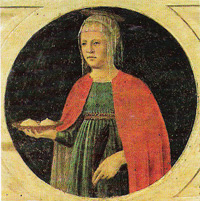 St Agatha from the predella of The St Anthony Polyptych (Perugia, Galleria Nationale dell' Umbria). St Agatha from the predella of The St Anthony Polyptych (Perugia, Galleria Nationale dell' Umbria).
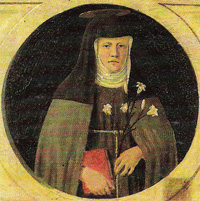 St Claire from the predella of The St Anthony Polyptych (Perugia, Galleria Nationale dell'Umbria). St Claire from the predella of The St Anthony Polyptych (Perugia, Galleria Nationale dell'Umbria). |

Art in Tuscany | Giorgio Vasari's Lives of the Artists | Piero della Francesca |
|
|
|
|
| |
|
| In the footsteps of Piero della Francesca |
|
|
|
An itinerary ful of art and beauty, in Tuscany, Umbria and Le Marche | Starting from Sansepolcro, his hometown, follow this itinerary, and see his greatest work of Piero della Francesca in Sansepolcro, Perugia, Urbino, Arezzo, Rimini and eventually Florence.
Itinerary in Central Italy | In the footsteps of Piero della Francesca
|

Art in Tuscany | Piero della Francesca in central Italy, an itinerary full of artistic and historical beauty
|
|
This article incorporates material from the Wikipedia article Polyptych of Perugia published under the GNU Free Documentation License.
Wikimedia Commons has media related to Polittico di Sant'Antonio.
|
| |
|
|



Holiday accomodation in Tuscany | Podere Santa Pia | Artist and writer's residency
|
| |
|
|
|
|

. |
|
|
Podere Santa Pia |
|
Podere Santa Pia, garden view, April |
|
View from Podere Santa Pia
on the Maremma hills |
| |
|
|
|
|
|
|
|
|
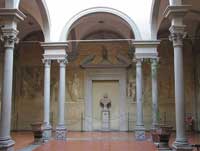
|
Villa Celsa near Florence |
|
Piazza della Santissima Annunziata
in Florence |
|
Choistro dello Scalzo, Florence |
| |
|
|
|
|
|
|
|
|
|
Palazzo Medici Riccardi, Florence |
|
Piazza della Santissima Annunziata
in Florence |
|
Arezzo |
| |
|
|
|
|
| |
|
|
|
|
|
|
| |
|
|
|
| |
|
|
|
| |
|
|
|
| |
|
|
|
| |
|
|
|
| |
|
|
|
![]()



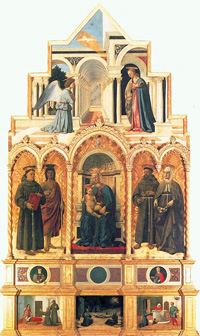
 St Agatha from the predella of The St Anthony Polyptych (Perugia, Galleria Nationale dell' Umbria).
St Agatha from the predella of The St Anthony Polyptych (Perugia, Galleria Nationale dell' Umbria). St Claire from the predella of The St Anthony Polyptych (Perugia, Galleria Nationale dell'Umbria).
St Claire from the predella of The St Anthony Polyptych (Perugia, Galleria Nationale dell'Umbria).